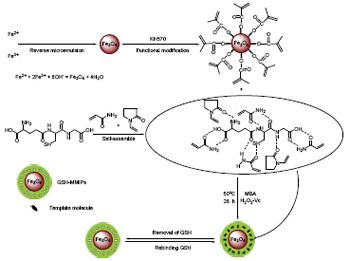

Preparation and Adsorption Property of Glutathione Magnetic Molecularly Imprinted Polymers
Received date: 2014-03-19
Online published: 2014-04-10
Supported by
Project supported by the National Natural Science Foundation of China (Grant No. 51061009).
The aim of this work was to produce a kind of magnetic molecular imprinted polymers (MMIPs) with core-shell structure and good magnetic separation performance. Compared with the preparation of traditional MIPs, a novel process was adopted to prepare MMIPs with good simplicity, flexibility and selectivity, in which Fe3O4 NPs were firstly prepared by a reverse microemulsion method, and subsequently directly added to the mixed solution to undergo the polymerization reaction without washing and drying. This method avoids availably the agglomeration and oxidation of Fe3O4 NPs. The MMIPs for glutathione (GSH) specific recognition (GSH-MMIPs), with core-shell structure, were prepared via one-step method polymerization, in which GSH as template molecule, N-vinylpyrrolidone (NVP) and acrylamide (AM) as functional monomers, N,N'-methylene bisacrylamide as crosslinker, H2O2-Vc as initiator and Fe3O4 nanoparticles (NPs) modified with γ-methacryloxypropyltrimethoxysilane (KH-570) as magnetic carrier. The as-prepared polymers were characterized by using of X-ray diffraction (XRD), transmission electron microscopy (TEM), Fourier transform infrared (FT-IR) spectroscopy and vibrating sample magnetometer (VSM). The results demonstrated that an imprinted polymer layer was successfully coated onto the surface of modified Fe3O4 NPs, resulting in a narrow diameter distribution and good magnetic responsibility. The specific adsorption equilibrium and selectivity were evaluated by batch rebinding studies. The Scatchard analysis showed that there were two kinds of binding sites in the GSH-MMIPs, the dissociation constants were 8.786×10-4 mol/L and 5.424×10-3 mol/L, and the corresponding maximum adsorption capacities of GSH onto GSH-MMIPs were 49.195 mg/g and 155.003 mg/g, respectively. The selectivity of the GSH-MMIPs was also evaluated to determine the rebinding capability of GSH and its analogues, compared with that of the magnetic non imprinted polymers (MNIPs) with similar chemical components. The GSH-MMIPs with high imprinting factor of 3.99 indicated that it was of good selectivity. This protocol was further employed for the extraction and separation of GSH from an aqueous solution.

Wang Rujuan , Ma Yingxia , Lu Cuiping , Li Tao , Du Xueyan . Preparation and Adsorption Property of Glutathione Magnetic Molecularly Imprinted Polymers[J]. Acta Chimica Sinica, 2014 , 72(5) : 577 -582 . DOI: 10.6023/A14030196
[1] Tamayo, F. G.; Turiel, E.; Martin-Esteban, A. J. Chromatogr. A 2007, 1152, 32.
[2] Wulff, G. Chem. Rev. 2002, 102, 1.
[3] Wang, H.-J.; Zhou, W.-H.; Yin, X.-F.; Zhuang, Z.-X.; Yang, H.-H.; Wang, X.-R. J. Am. Chem. Soc. 2006, 128, 15954.
[4] Gupta, R.; Kumar, A. Biotechnol. Adv. 2008, 26, 533.
[5] Guerreiro, A. R.; Korkhov, V.; Mijangos, I.; Piletska, E. V.; Rodins, J.; Turner, A. P. F.; Piletsky, S. A. Biosens. Bioelectron. 2008, 23, 1189.
[6] Lorz, C.; Segrelles, C.; Garín, M.; Paramio, J. M. Methods Mol. Biol. 2010, 585, 1.
[7] Zhang, L.; Qiao, S.-Z.; Jin, Y.-G.; Chen, Z.-G.; Gu, H.-C.; Lu, G.-Q. Adv. Mater. 2008, 20(4), 805.
[8] B??lková, Z.; Slováková, M.; Ly?ka, A.; Horák, D.; Lenfeld, J.; Turková, J.; Churá?ek, J. J. Chromatogr. B 2002, 770(1/2), 25.
[9] Pan, C. L.; Hu, B.; Li, W.; Sun, Y.; Ye, H.; Zeng, X. X. J. Mol. Catal. B: Enzym. 2009, 61(3/4), 208.
[10] Zhang, L.; Wang, W. Z.; Shang, M.; Sun, S. M.; Xu, J. H. J. Hazard. Mater. 2009, 172(2/3), 1193.
[11] Tian, H.; Li, J.-J.; Shen, Q.; Wang, H.-L.; Hao, Z.-P.; Zou, L.-D.; Hu, Q. J. Hazard. Mater. 2009, 171(1/3), 459.
[12] Kong, X.; Gao, R.-X.; He, X.-W.; Chen, L.-X.; Zhang, Y.-K. J. Chromatogr. A 2012, 1245, 8.
[13] Li, H.; Xu, W.-Z.; Wang, N.-W.; Ma, X.-H.; Niu, D.-D.; Jiang, B.; Liu, L.-K.; Huang, W.-H.; Yang, W.-M.; Zhou, Z.-P. Microchim. Acta 2012, 179, 123.
[14] Dai, J.-D.; Pan, J.-M.; Xu, L.-C.; Li, X.-X.; Zhou, Z.-P.; Zhang, R.-X.; Yan, Y.-S. J. Hazard. Mater. 2012, 205-206, 179.
[15] Xin, Y.; Tong, Y.-J.; Yang, H.-L.; Zhang, L.; Zhang, Y.-R.; Chen, Y.; Wang, W. Acta Chim. Sinica 2012, 70(6), 803. (辛瑜, 仝艳军, 杨海麟, 张玲, 张玉然, 陈亦, 王武, 化学学报, 2012, 70(6), 803.)
[16] Liu, Q.-Y.; Li, W.-Y.; He, X.-W.; Chen, L.-X.; Zhang, Y.-K. Acta Chim. Sinica 2008, 66(1), 56. (刘秋叶, 李文友, 何锡文, 陈朗星, 张玉奎, 化学学报, 2008, 66(1), 56.)
[17] Li, Q.; Du, Y.-L.; Yang, K.-K.; Li, F. Chem. J. Chin. Univ. 2007, 28(6), 1059. (李琼, 杜艳丽, 杨科珂, 李方, 高等学校化学学报, 2007, 28(6), 1059.)
/
| 〈 |
|
〉 |